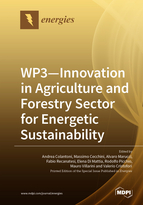WP3 – Innovation in Agriculture and Forestry Sector for Energetic Sustainability
A special issue of Energies (ISSN 1996-1073). This special issue belongs to the section "A: Sustainable Energy".
Deadline for manuscript submissions: closed (30 June 2020) | Viewed by 65634
Special Issue Editors
Interests: energy; environment; agriculture
Special Issues, Collections and Topics in MDPI journals
Interests: agricultural machinery; occupational safety and health; ergonomics; agriculture; energy
Special Issues, Collections and Topics in MDPI journals
Interests: green buildings, greenhouses, sustainable development; sustainable agriculture
Interests: remote sensing sustainable development; sustainable strategies and policies; peri-urban areas; land use planning
Interests: renewable energy; microbiology and biotechnology
Interests: forest utilizations; logging activities; reduced impact logging; sustainable forest management; forest restoration systems
Special Issues, Collections and Topics in MDPI journals
Interests: energy; environment; agriculture
Special Issues, Collections and Topics in MDPI journals
Interests: temperate fruit trees and nut crops; innovation in orchard management; traditional and innovative fruit plant propagation systems; precision agriculture applications on nut crops
Special Issues, Collections and Topics in MDPI journals
Special Issue Information
Dear Colleagues,
This Special Issue was founded after the creation of a department of excellence at the University of Tuscia (Viterbo, Italy). In particular, in the context of the WP3 objective, there is a need of innovation in the agricultural and forestry sectors for energy sustainability. Renewable energy sources and the rational use of energy represent an important agricultural and forestry resource in a local context against climate change.
The first issue that this Special Issue will address is identifying the energy potential from agro-forestry biomass, also dealing with the production of agricultural and forestry biomass in terms of supply and logistics; short rotation forestry (SRF); agricultural and forestry residues and their valorization; the main techniques of cultivation, the mechanization of biomass production, harvesting and pre-treatment; the energy and environmental balance of biomass production; further forms of by-product valorization; evaluation of the potential of land use (GIS—Geographic Information Systems) and planning tools.
The second issue focuses on the performance analysis of prototypal systems for energy conversion, including hydrogen, power and/or heat production plants and the pertinent thermodynamic cycles; sustainable renewable energy technologies (RETs); biomass thermochemical energy conversion technologies, such as combustion, gasification, and pyrolysis; biomass biochemical energy conversion technologies, such as fermentation and anaerobic digestion; system analysis and the integration of production and conversion; and integrated bioenergy systems. Economic, environmental and management aspects of the mentioned technologies will be considered.
The third issue focuses on energy sustainability for environmental mitigation such as the impact of large-scale/small-scale bioenergy systems; enhancement of the by-products of thermochemical processes (biochar) for the improvement of the agricultural and forestry sector; evaluation of CO2 storage in the soil and combating desertification; and energy efficiency.
Prof. Andrea Colantoni
Prof. Massimo Cecchini
Prof. Alvaro Marucci
Dr. Fabio Recanatesi
Dr. Elena Di Mattia
Prof. Rodolfo Picchio
Eng. Mauro Villarini
Prof. Valerio Cristofori
Guest Editors
Manuscript Submission Information
Manuscripts should be submitted online at www.mdpi.com by registering and logging in to this website. Once you are registered, click here to go to the submission form. Manuscripts can be submitted until the deadline. All submissions that pass pre-check are peer-reviewed. Accepted papers will be published continuously in the journal (as soon as accepted) and will be listed together on the special issue website. Research articles, review articles as well as short communications are invited. For planned papers, a title and short abstract (about 100 words) can be sent to the Editorial Office for announcement on this website.
Submitted manuscripts should not have been published previously, nor be under consideration for publication elsewhere (except conference proceedings papers). All manuscripts are thoroughly refereed through a single-blind peer-review process. A guide for authors and other relevant information for submission of manuscripts is available on the Instructions for Authors page. Energies is an international peer-reviewed open access semimonthly journal published by MDPI.
Please visit the Instructions for Authors page before submitting a manuscript. The Article Processing Charge (APC) for publication in this open access journal is 2600 CHF (Swiss Francs). Submitted papers should be well formatted and use good English. Authors may use MDPI's English editing service prior to publication or during author revisions.
Keywords
- agriculture
- forestry
- energies
- sustainable development
- climate change
- landscape
- microbiology
- crops
- process design
- thermodynamic analysis
- gasification process
- anaerobic digestion
- hydrogen











